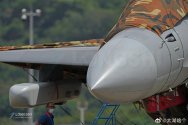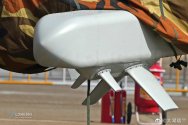Ahh thanks!Official news? Unlikely.
But the grapevine might let something slip in relation given J-16Ds public unveiling.
I do believe there's enough noise to say there's little a new ARM in the works.
You are using an out of date browser. It may not display this or other websites correctly.
You should upgrade or use an alternative browser.
You should upgrade or use an alternative browser.
China Flanker Thread II
- Thread starter sumdud
- Start date
- Status
- Not open for further replies.
I mean, if Taiwan, Korea and Japan are considered threats (which they are), then I do think they have a high demand on anti-radiation missiles. All 3 have quite sophisticated anti-air networks that had to be dealt with.Does China need to put as much emphasis on anti-rad missiles as the USA? The number one factor that fueled American anti-rad missile development was the Soviet/Russian air defense network which had more than 9000 launchers and thousands of radars at its peak. China does not face such a force so less emphasis on such missiles may save some money.
Large jamming pods on J-16D, three pods are visible but I wouldn't be surprised if there is another one under the aircraft's left wing as well.
Very much looking the profile of a contemporary tactical jammer.
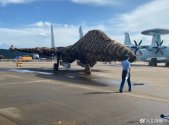
I'm unsure if these pods are in service with the PLA, as in past airshows we have seen in service PLA aircraft shown with export intended payloads -- but at the same time, J-16D is such a unique aircraft that I'd be surprised that they'd stick pods onto J-16D willy nilly.
As for the pods themselves -- the two pods under the intakes look like they are of the same type. We can see a reasonably sized ram air intake on their ventral side, and a bulbous nose/tip radome is visible as well. I wouldn't be surprised if the tail end of those pods also have a radome.
The pod we can see under the wing appears to be slightly smaller, and from the angle I cannot see a ventral ram air intake but I think that is because the front nose/tip radome is so large and protrudes ventrally slightly, blocking the likely ventral air intake from sight.
Both of these pod designs seem different from the ECM pods we've seen equipped on JH-7/A in the past, on J-11B, and on H-6KG/J.
Given the large protruding radomes, I suspect that is the position of the primary antennae, and I wouldn't be surprised if another antennae was present on the rear side of the pod as well.
That would not be dissimilar to how the KG-600/800 series pods seems to have their arrays arranged, and would of course be similar to the NGJ pod as well.
Given the technologies that are mature, I somewhat expect these pods to have AESA antennae, but that can't be taken for granted.
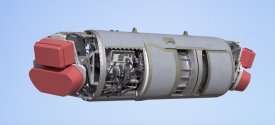
If there are indeed four pods (and by all logic that would prove to be a sensible and symmetric loadout), the pods are likely to cover different bands. Compared to EA-18G, which at present carries three ALQ-99 pods for most missions, or in the future will carry three NGJ pods covering different bands with potentially two smaller NGJ pods (for a total of five), a four pod system of reasonably sized pods for a standard EW loadout is an interesting choice.
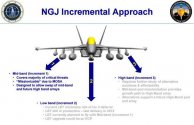
Each individual pod is likely to be slightly less powerful than a larger pod (like the current midband NGJ in flight tests), but offers greater flexibility.
Of course, we also cannot rule out the possibility that additional EW pods can be added over time as well.
The loadout so far in the picture is not equipped with any weapons that we can see either, whether it be AAMs or ARMs.
In any case, so far at Zhuhai I'd say the official revelation of J-16D in such a high quality manner is probably the biggest surprise so far, and even more so if they are showing these new EW pods intended to be in service with the aircraft.
Very much looking the profile of a contemporary tactical jammer.

I'm unsure if these pods are in service with the PLA, as in past airshows we have seen in service PLA aircraft shown with export intended payloads -- but at the same time, J-16D is such a unique aircraft that I'd be surprised that they'd stick pods onto J-16D willy nilly.
As for the pods themselves -- the two pods under the intakes look like they are of the same type. We can see a reasonably sized ram air intake on their ventral side, and a bulbous nose/tip radome is visible as well. I wouldn't be surprised if the tail end of those pods also have a radome.
The pod we can see under the wing appears to be slightly smaller, and from the angle I cannot see a ventral ram air intake but I think that is because the front nose/tip radome is so large and protrudes ventrally slightly, blocking the likely ventral air intake from sight.
Both of these pod designs seem different from the ECM pods we've seen equipped on JH-7/A in the past, on J-11B, and on H-6KG/J.
Given the large protruding radomes, I suspect that is the position of the primary antennae, and I wouldn't be surprised if another antennae was present on the rear side of the pod as well.
That would not be dissimilar to how the KG-600/800 series pods seems to have their arrays arranged, and would of course be similar to the NGJ pod as well.
Given the technologies that are mature, I somewhat expect these pods to have AESA antennae, but that can't be taken for granted.

If there are indeed four pods (and by all logic that would prove to be a sensible and symmetric loadout), the pods are likely to cover different bands. Compared to EA-18G, which at present carries three ALQ-99 pods for most missions, or in the future will carry three NGJ pods covering different bands with potentially two smaller NGJ pods (for a total of five), a four pod system of reasonably sized pods for a standard EW loadout is an interesting choice.

Each individual pod is likely to be slightly less powerful than a larger pod (like the current midband NGJ in flight tests), but offers greater flexibility.
Of course, we also cannot rule out the possibility that additional EW pods can be added over time as well.
The loadout so far in the picture is not equipped with any weapons that we can see either, whether it be AAMs or ARMs.
In any case, so far at Zhuhai I'd say the official revelation of J-16D in such a high quality manner is probably the biggest surprise so far, and even more so if they are showing these new EW pods intended to be in service with the aircraft.
Last edited:
Another angle -- showing the pod on the left wing. I wondered if the previous picture had some ventral antennae on the left pod, and it seems like it indeed is different from the pod on the right wing.
This angle also shows how big the pods below the intakes are....
I imagine once the exhibition begins and the aircraft is uncovered we will get much better details and perspectives for its size.
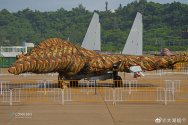
This angle also shows how big the pods below the intakes are....
I imagine once the exhibition begins and the aircraft is uncovered we will get much better details and perspectives for its size.

Hmm, so could it be they're already attempting to cover high, low and mid bands? Assuming the large pods under intakes are mid band systems, like the biggest pods on Growler are. Right wing pod doesn't seem to be much smaller though, and it seems to have the bulbous head just like the ones under the intakes. Not sure if it could be for a different band...
It's the left wing pod that seems to be different, slightly slimmer, with a different nose. And of course, those antennas are an addition. Perhaps it's even an ESM pod, though having just one, partially blocked by the plane's fuselage seems strange. Then again, maybe the large fins could be part of the low band system, as that should by some logic require fairly long antennas. I guess these might be long enough to affect part of the UHF band, but perhaps not all of it.
It's the left wing pod that seems to be different, slightly slimmer, with a different nose. And of course, those antennas are an addition. Perhaps it's even an ESM pod, though having just one, partially blocked by the plane's fuselage seems strange. Then again, maybe the large fins could be part of the low band system, as that should by some logic require fairly long antennas. I guess these might be long enough to affect part of the UHF band, but perhaps not all of it.
The one shown in the first image looks like a cruise missile type jammer to me.
Is there a naval version J-15D that can land on carrier ?
J-15D is a naval aircraft.
- Status
- Not open for further replies.

